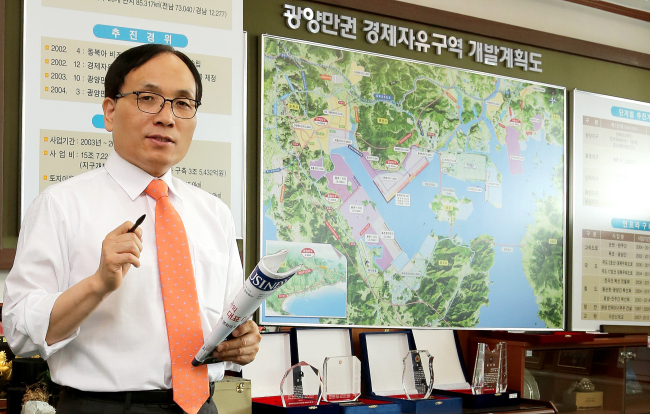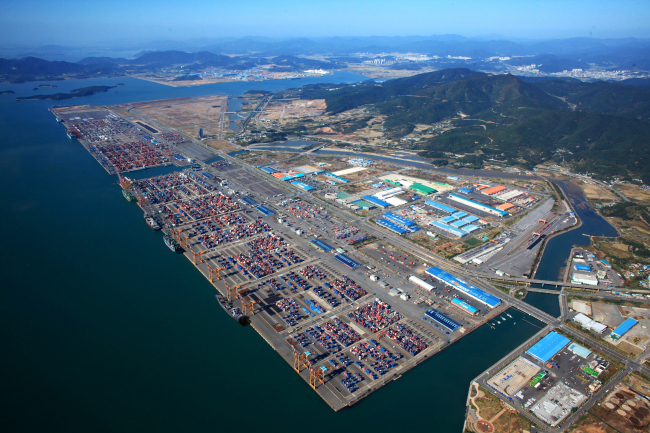Commissioner aims to grow GFEZ into logistics hub of Northeast Asia
Free economic zone seeks to attract investment worth $25 billion by 2020
By Korea HeraldPublished : Nov. 19, 2013 - 15:43
Looking at a map of the Korean Peninsula, it can be clearly seen that Gwangyang Port, in South Jeolla Province, is located halfway between China and Japan.
Covering four different cities and counties (Yeosu, Suncheon and Gwangyang in South Jeolla Province, and Hadong in South Gyeongsang Province), the Gwangyang Bay Area Free Economic Zone, or GFEZ, is a key strategic location for both Western and Asian businesses that want to be involved in the Asian market.
With this year marking the 10th anniversary of the free economic zone, Lee Hee-bong, the commissioner of the GFEZ, expressed his satisfaction with its growth and how it has served as a new global business hub over the past decade.
“The GFEZ has far more strength and growth potential than other free economic zones,” Lee said in an interview. “First of all, more than 50 cities with a population of 1 million or more, such as Shanghai, Qingdao, Tianjin, and Kobe, are within a 1,200-kilometer radius. Its comparatively low land value (about a third of that of Seoul’s metropolitan area) puts a minimal burden on companies during initial settlement.”
Covering four different cities and counties (Yeosu, Suncheon and Gwangyang in South Jeolla Province, and Hadong in South Gyeongsang Province), the Gwangyang Bay Area Free Economic Zone, or GFEZ, is a key strategic location for both Western and Asian businesses that want to be involved in the Asian market.
With this year marking the 10th anniversary of the free economic zone, Lee Hee-bong, the commissioner of the GFEZ, expressed his satisfaction with its growth and how it has served as a new global business hub over the past decade.
“The GFEZ has far more strength and growth potential than other free economic zones,” Lee said in an interview. “First of all, more than 50 cities with a population of 1 million or more, such as Shanghai, Qingdao, Tianjin, and Kobe, are within a 1,200-kilometer radius. Its comparatively low land value (about a third of that of Seoul’s metropolitan area) puts a minimal burden on companies during initial settlement.”

Born in Damyang, South Jeolla Province, Lee earned his Ph.D in urban and regional studies from the University of Birmingham, in England, in 2002. Since passing the country’s highest civil service examination, he has served in various positions, including as the public/government program director at the OECD’s Korean Policy Center.
Other major benefits for GFEZ-based companies are the rich local culture and tourist attractions in the area and the mild climate. Also, it is not far from the pristine Seomjin River, Mt. Jiri, and the picturesque Hallyeohaesang National Park, a maritime park with a scenic coastline and islands. The area encompassed by the GFEZ is attracting an increasing number of tourists from both here and abroad.
The area’s remarkable environment was a key driving force behind the success of several large-scale international events that took place in the region last year, such as the Yeosu Expo and Suncheon Bay Garden Expo. “Blessed with a wonderful natural environment, the GFEZ is steeped in culture and history as well,” Lee said.
Ease of access is another huge advantage for the GFEZ. The ports of Yeosu and Gwangyang, both more than 20 meters in depth, can accommodate vessels weighing up to 300,000 tons. Additionally, the recently opened Suncheon-Jeonju and Mokpo-Gwangyang highways, as well as the KTX high-speed trains running to and from the city of Yeosu, guarantee timely delivery of goods and services.

The GFEZ area has two attractive features for companies looking for a solid support infrastructure: POSCO Gwangyang Steel Works, with the world’s largest production capacity for crude steel, and the Yeosu National Industrial Complex, which makes up 56 percent of the domestic petrochemicals market.
Recognizing the GFEZ’s ideal location and investment environment, 142 companies have set up their base of production in the free economic zone so far, with $12.3 billion invested and 30,000 jobs created. Last year alone, despite the ongoing economic slump, it attracted $1.38 billion in foreign capital from 20 different countries.
Earlier this year, GFEZ officers visited cities in western Japan, including Nagoya, Osaka, and Kitakyushu, in an effort to attract Japanese technology companies to the free economic zone. In China, two Korean metal companies that were previously based in Korea have agreed to move their production facilities to the GFEZ, an investment decision worth $10 million. Although local companies don’t receive tax incentives for setting up their businesses in the GFEZ, because of its excellent location and business environment, about 100 Korean companies have also decided to come here.
For four years in a row, the GFEZ has been a runner-up in the free economic zone evaluation by the Ministry of Trade, Industry, and Energy, in recognition of its efforts to offer tax incentives, ease regulations, and provide useful training.
The commissioner also pointed out that, “Besides these efforts, we provide services that are not offered in other free economic zones, such as assistance services catering to the needs of GFEZ-based companies, education programs provided with the cooperation of regional colleges, and various mileage programs.”
In March, the GFEZ announced its “2020 New Vision,” with the goal of growing into an industrial and logistics center of Northeast Asia by attracting $25 billion in investment and creating 240,000 new jobs.
The new vision also highlights five strategies that will turn the GFEZ into a leisure, education, and medical hub of the country.
According to Lee, one urgent issue related to the GFEZ is the development of the Gwangyang Sepung Industrial Complex. The 360.6 billion won project is scheduled to be completed by 2015. Building a petrochemical cluster within the free economic zone is another important issue to deal with.
“For the future growth of the Korean chemical industry, we need to have more chemical companies based in the GFEZ, taking advantage of the existing facilities of the Yeosu National Industrial Complex. I expect that the government will support us in achieving this goal,” Lee said.
(khnews@heraldcorp.com)
-
Articles by Korea Herald




![[Herald Interview] 'Amid aging population, Korea to invite more young professionals from overseas'](http://res.heraldm.com/phpwas/restmb_idxmake.php?idx=644&simg=/content/image/2024/04/24/20240424050844_0.jpg&u=20240424200058)













![[KH Explains] Korean shipbuilding stocks rally: Real growth or bubble?](http://res.heraldm.com/phpwas/restmb_idxmake.php?idx=652&simg=/content/image/2024/04/25/20240425050656_0.jpg&u=)

